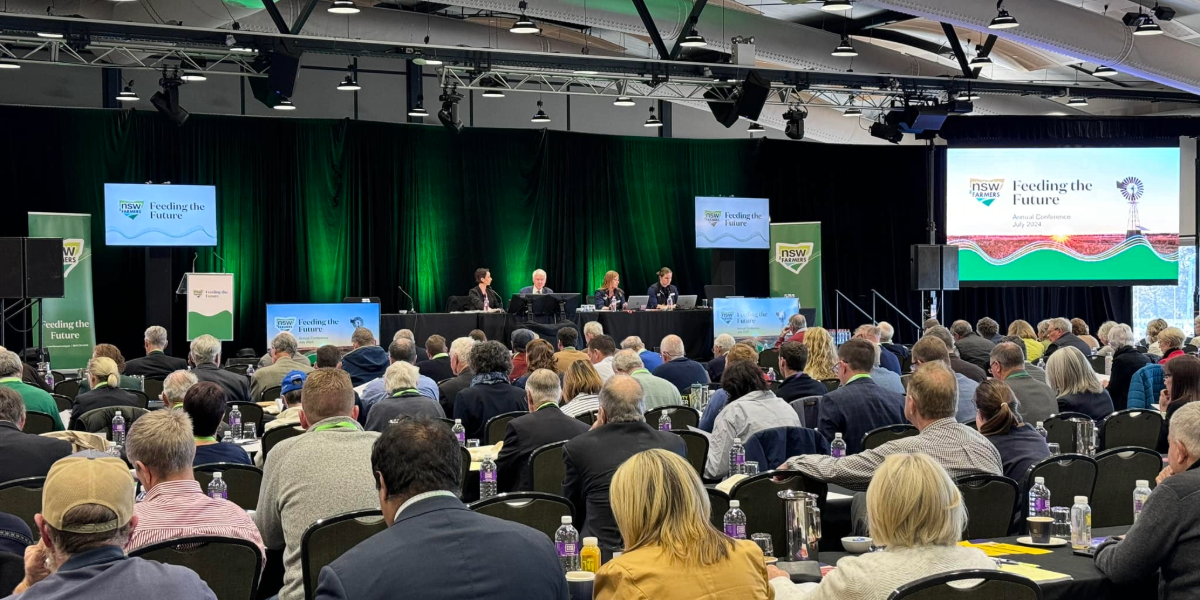An eyebrow-raising proposal at the NSW Farmers Annual General Conference has seen the state’s leading farmer body commit themselves to lobbying for renewable energy projects to entirely – and exclusively – fund local councils.
Motion E09 from the Guyra Branch was relatively straight forward in its wording: ‘NSWFA requires a separate rating category to be implemented for renewable projects’. That is, they want a separate rates category to be applied to land with renewable projects on them, rather than being charged farmland rates.
But when former NSW Farmers President James Jackson rose to speak to the motion, his intent was far more aggressive, arguing that the entire rate base of the area should be borne by renewable projects, and no one else should have to pay rates ever again. He confidently asserted that the cost would not be borne by his fellow farmers who host renewable projects and who get the rates bill, but would be covered by the renewable companies.
Jackson was unabashed in bluntly describing his proposal – which NSW Farmers has no power to implement and can only expend their limited resources lobbying for – as “a sweet plan… a cunning plan to make the buggers pay”.
“Well, if they put turbines like hairs on a dog’s back all over the New England, then they can pay the entire rate base forever,” he said.
“This will make them think about a their social licence. It’ll make them think about the economics of where to put them. You know, there may be somewhere in the state that people are happy to have them,” Dr Jackson said.
Tenterfield Mayor Bronwyn Petrie, who was re-elected to the board of NSW Farmers yesterday, spoke in favour of the motion, revealing that the mayors of the New England councils are being encouraged to look at ways they can levy more money from renewable projects.
Pork Committee Chair Edwina Beveridge spoke against the motion, arguing the small scale methane digestion projects that the pig farmers of NSW are doing would also be penalised under the proposal, while Mark Horan, an Executive Council member and long term leader in the organisation, opposed the motion because it would amount to naught.
“The council can do whatever they want after [the introduction of the new rates category] happens – it doesn’t necessarily mean that the money is going to be all drawn from the renewable project proponent.”
“It just means that there’s another rate category, and I fail to see how it is actually going to do anything,” Mr Horan said.
The emotive and ideologically charged rhetoric of Jackson and others, including questionable claims around both the number of renewable developments and lack of consultation, colourful imputations that councils and communities were being bribed, and repeated assertions that the renewable projects had no social licence, was, however, persuasive, with the motion carried.
Better models readily available
Director of the Community Power Agency, Kim Mallee, says that communities absolutely should share in the wealth generated by renewable projects.
“There should be value flowing from the energy transition to farmers and regional communities.”
“Benefit sharing is a very established industry norm within the wind industry.”
“It’s an acknowledgment that the wind and the sun and water is a common asset, and the monetisation of that resource should be shared with the with the community that hosts these pieces of infrastructure,” she said.
However she felt the idea of having a single industry pay the entire rate burden for a region – even if feasible – is unfair and risky, and there are better models that are proven to be effective, as detailed in their recent discussion paper on Regional Benefit Sharing.
“Why would we pick any single industry?”
“What about regions that don’t host renewable energy? Why should they have to pay rates if another region with renewables does not – that’s not fair either.”
Mallee pointed to Victoria, where they have legislated that such developments pay an annual contribution to the local council called ‘payment in lieu of rates‘. This figure is factored in to the cost of doing business, and leaves the community clear to negotiate the benefit for them. However, in New South Wales the process of Voluntary Planning Agreements is not clearly delineated, meaning communities are sometimes negotiating in competition with their councils.
She also gave the example of Sapphire Wind Farm near Inverell, which gave the opportunity of co-investment to the community. It was the first such project in Australia to open up a public investment process, attracting $1.8 million of investment from roughly 100 investors, many of whom were local to the area.
“The community co-designed that model,” she said.
“So that’s a way of distributing wealth very tangibly.”
The New England has been consistently found to be highly supportive of renewable energy in most public opinion research going back over the last 15 years. The area is replete with case studies of farmers and communities uniting to make the most of the renewables transition. A number of local developments, including Sapphire, ACEN’s New England Solar Farm at Uralla and the Oven Mountain Pumped Hydro Scheme near Armidale, are often held up as exemplars of community engagement and developments that enjoy extraordinary social licence.
Attacks based on ideology
Dr Jackson was less successful in his campaign against renewable projects later in the day, with another motion put forward by the Guyra Branch for a moratorium on industrial scale wind and solar developments failing to pass.
“This is a rolling mess and a moratorium from this organisation… will give our key spokespeople a really good opportunity to talk about the angst in the community,” he said.
Others argued the motion was based on ideology and renewable projects were critical for the nation’s future power supply.
Walcha farmer Warwick Fletcher, who has been a prominent supporter of wind developments at Walcha, said NSW had the slowest project planning approvals in Australia, and the state would need more than double its current electricity supply by 2025.
“The crux of the matter is we need electricity.”
“The more you have, the cheaper it is,” he said.
There are no solar or wind projects at Guyra, either current or planned, while Walcha has one of the highest concentrations of proposals due to its near-perfect conditions for wind power generation.
Like what you’re reading? Support New England Times by making a small contribution today and help us keep delivering local news paywall-free. Support now


